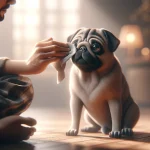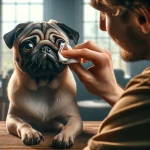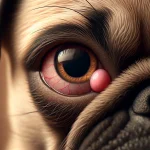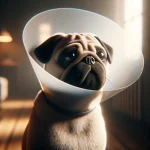Table of Contents
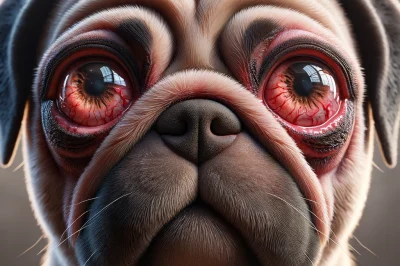
Key Takeaways
- Dry eye, or keratoconjunctivitis sicca (KCS), is a common condition in pugs that requires attention and care.
- Spotting the signs of dry eye early can prevent discomfort and more serious complications for your pug.
- Home remedies like regular cleaning and maintaining a dust-free environment can help manage mild symptoms.
- For more severe cases, veterinary intervention with prescription medication and possibly surgery may be necessary.
- Continuous care, including diet and regular check-ups, is key to managing your pug’s dry eye condition effectively.
Understanding Pug Dry Eye: A Stubborn Issue
Dry eye, scientifically known as keratoconjunctivitis sicca (KCS), is not just an uncomfortable annoyance for your pug; it’s a health issue that, if left unaddressed, can lead to serious eye problems, including blindness. But don’t worry! With the right knowledge and care, you can keep your pug’s peepers healthy and sparkling.
The Basics of Pug Dry Eye
Think of tears as a protective river that keeps the eyes clean and comfortable. When that river runs dry, we’re talking about dry eye. In pugs, this can happen because their tear glands don’t produce enough moisture, often due to their unique facial structure or immune system issues. This lack of tears leads to sore, red, and itchy eyes that can make your little buddy miserable.
Identifying the Signs of Dry Eye
Keep an eye out for telltale signs of dry eye in your pug: redness, rubbing at their eyes, a thick discharge, or what looks like an unending case of sleep in their eyes. If you notice these symptoms, it’s time to step up your care game. Because, remember, spotting and treating dry eye early can save your pug from a heap of discomfort and more serious eye damage down the line.
First-Line Defense: At-Home Care Strategies
Regular Cleaning and Eye Hygiene
First things first, you’ll want to keep your pug’s eyes clean. This means gently wiping away any gunk with a damp, soft cloth. Always wipe from the corner of the eye outward and use a separate section of the cloth for each eye to avoid spreading any infection. For more detailed information on maintaining your pug’s eye health, consider reading this comprehensive guide on pug eye health and conditions.
Creating a Comfortable Environment
Besides that, consider your home environment. Pugs are sensitive to dust and irritants, which can exacerbate dry eye. Make sure their bedding is washed regularly, and keep your floors and surfaces dust-free. A humidifier can also add some much-needed moisture to the air, especially in dry climates or during winter months.
When to Seek Veterinary Care
Decoding Symptoms: When It’s More Than Just Dry Eyes
If your pug’s eyes are getting worse despite your best at-home care, or if they’re showing signs of pain like whining or reluctance to open their eyes, it’s time to get your vet involved. They have the tools to diagnose the severity of dry eye and can provide treatment options that go beyond what you can do at home.
Seeking Expert Diagnosis
Your vet will likely perform a test called the Schirmer Tear Test to measure tear production and determine if your pug has dry eye. This simple, painless procedure can tell your vet a lot about what’s going on and is the first step toward getting your pug the relief they need.
Professional Treatments for Dry Eye
When at-home methods aren’t enough, it’s time to consider professional treatments for your pug’s dry eye. These treatments are designed to either stimulate tear production or replace tears. A vet can provide a personalized treatment plan after assessing your pug’s specific needs.
Prescribed Medications: What Works Best?
Most importantly, your vet may prescribe medications that stimulate tear production or serve as artificial tears. Cyclosporine and tacrolimus are common immunosuppressive drugs used to treat KCS by reducing inflammation in the tear glands and boosting tear production. Artificial tear solutions or ointments can also be used to keep the eyes moist and protected.
Tear Production Improvement Techniques
For some pugs, tear duct surgery might be an option. This procedure, known as parotid duct transposition, redirects saliva to the eye to compensate for the lack of tears. It’s a more invasive option but can be a lifesaver for pugs with severe dry eye.
Managing Ongoing Care and Costs
Dealing with dry eye is a lifelong commitment. You’ll need to be consistent with treatments and check-ups to ensure your pug’s eyes stay healthy. This might sound daunting, but once you get into a routine, it becomes just another part of loving and caring for your furry friend.
Developing a Long-Term Treatment Plan
Your vet will help you develop a long-term treatment plan. This might include daily medications, regular vet visits, and monitoring for any changes in your pug’s eye health. Consistency is key, so make sure to follow your vet’s instructions to the letter.
Here’s what a long-term treatment plan might include:
- Daily administration of prescribed eye drops or ointments.
- Regular cleaning and wiping of your pug’s eyes to prevent infection.
- Bi-annual vet check-ups to monitor the condition and adjust treatments as needed.
Understanding the Financial Aspect of Treatment
Let’s talk numbers. The cost of treating dry eye can vary widely. For example, prescription medications like cyclosporine can cost between $30 to $50 per month. If surgery is needed, the price can jump significantly. It’s wise to factor these potential costs into your budget or consider pet insurance to help manage expenses.
Lifestyle Adjustments for Your Pug
Diet and Nutrition Tips for Eye Health
What your pug eats can impact their eye health. Omega-3 fatty acids, found in fish oil supplements, can help reduce inflammation and improve tear quality. Antioxidants like vitamins A, C, and E can also support eye health. Ask your vet for specific dietary recommendations or supplements that might benefit your pug.
Exercise and Its Role in Managing Dry Eye
Believe it or not, regular exercise can help with your pug’s dry eye. It stimulates blood flow and can help reduce the risk of obesity, which can exacerbate health issues. Just be mindful of your pug’s breathing and avoid strenuous activity, especially in hot weather.
Tips and Remedies: Enhancing Your Pug’s Quality of Life
Holistic Approaches: Supplements and Natural Remedies
In addition to conventional treatments, some pug owners have found success with holistic approaches. Natural supplements like flaxseed oil or eyebright herb might offer some relief. However, always consult your vet before adding any new supplements to your pug’s diet.
Proactive Measures to Prevent Dry Eye Flare-ups
To keep your pug’s eyes as healthy as possible, you can take proactive measures to prevent flare-ups. This includes keeping up with their grooming to avoid hair irritating their eyes and protecting their eyes from wind and sun with doggy goggles when outdoors.
Prioritizing Your Pug’s Eye Health
Maintaining Regular Veterinary Check-ups
Regular check-ups are crucial for keeping your pug’s dry eye under control. Your vet can catch any changes in their condition early, which can make all the difference in managing the disease effectively. These visits are also a great time to discuss any concerns or observations you’ve made about your pug’s eye health.
Staying Informed on Latest Treatment Options
Besides regular vet visits, staying informed about the latest treatment options is essential. Research on dry eye is always evolving, and new medications or therapies might become available. Keeping in touch with your vet and doing your own reading can help you provide the best care for your pug.
Frequently Asked Questions
For more detailed information on how to care for your pug’s eyes, please refer to our comprehensive guide on pug eye care.
Is dry eye in pugs a curable condition?
While dry eye in pugs is typically not curable, it is manageable. With proper care, many pugs with dry eye can lead comfortable, happy lives. The key is early detection and consistent treatment.
Can human eye drops be used for pug dry eye?
While it’s important to consult with a veterinarian before using any treatment, for more information on pug eye health, you might want to read about the best artificial tears and eye health tips for pugs.
It’s important to use only vet-recommended products for your pug’s dry eye. Human eye drops are not formulated for dogs and could potentially cause harm. Always consult your vet before using any over-the-counter products.
How often should I clean my pug’s eyes?
You should gently clean your pug’s eyes daily to remove any discharge and prevent build-up. If you notice more discharge than usual, it might be a sign that your pug’s dry eye is worsening, and you should contact your vet.
What diet helps support eye health in pugs?
A balanced diet rich in omega-3 fatty acids can support your pug’s eye health. Foods like fish and flaxseed are great sources. You can also ask your vet about supplements that may benefit your pug’s specific condition.
Are there preventive measures for pug dry eye?
While you can’t always prevent dry eye, you can reduce the risk of flare-ups by keeping your pug’s face clean, avoiding irritants like smoke and dust, and maintaining a healthy diet. Regular vet visits are also important for early detection and prevention.
Pugs are prone to a condition known as dry eye, or keratoconjunctivitis sicca (KCS), which can cause discomfort and vision problems if left untreated. It’s important to keep an eye on your pug’s eye health and seek effective treatment options if you notice signs of dry eye. Regular visits to the vet, along with daily eye cleaning and the use of artificial tears, can help manage this condition and keep your pug’s peepers healthy.

